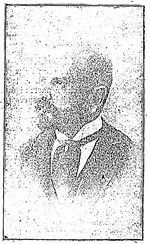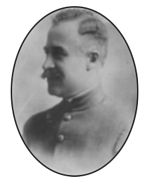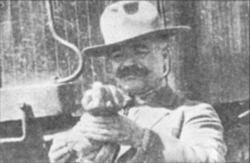Signatories of the Banco de Aguascalientes
Interventor
|
Vicente Mercado was Interventor from the founding of the bank until 11 December 1903. On 9 June 1902 Mercado wrote to Secretario Limantour about the position of interventor with his resume and references. In 1876 at the age of thirteen he had started working in a smelter, before moving to another business of the same owner. From July 1886 to January 1896 he worked for a casa comercial, and then moved on to manage a respectable French-owned business. Finally he could afford to set up on his own but was unable to make a success, so asked for this government postCEHM, Fondo CDLIV Colección José Y. Limantour, 2a. 1902, carpeta 18, legajo 119. He signed notes dated from 1902 to 1904. |
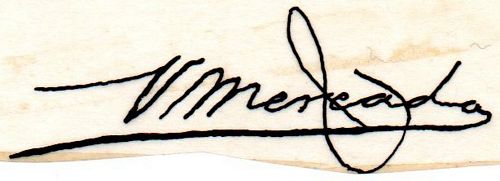 |
|
Carlos and his brother Rafael owned a haberdashery, furniture and hardware store in the centre of town. Carlos was a local deputy, and then served as state governor from 1899 to 1903 and was instrumental in developing the capital. He approved the organization of the Compañía Telefónica de Aguascalientes, which inaugurated communication between Zacatecas and Aguascalientes in 1901, and of which José León García, a rich Zacatecan landowner established in Aguascalientes, Genaro E. Kimball, Ignacio A. Ortiz, José Guadalupe Ortega and other good friends of governor Alejandro Vázquez del Mercado were membersEl Republicano, 22 September 1901. Although Carlos Sagredo had been associated more with governor Rafael Arellano, the links with Vázquez del Mercado were strengthened towards the end of the Porfiriato, as confirmed by the fact that he appeared in 1907 as "Honorary President" of the Circle of Friends of the Governor, with Dr. Marín, Genaro Kimball, Rafael Sagredo, Enrique C. Osornio and Alberto M. Dávalos La Voz de Aguascalientes, núm. 68, 25 October 1907. Carlos Sagredo signed some $50 notes dated 14 October 1903 but released in August 1904 and then notes dated from 1905 to 1910. He also signed some notes as Consejero. |
 |
|
J. González del Bosque signed the balance sheets from at least January 1912 to February 1913. He signed $500 and $1,000 notes dated 1 May 1907 but actually released in 1912. |
 |
|
Felipe Ruiz Chávez (or Felipe Ruiz de Chávez) was born in 1849. In 1885 he acquired a leather goods manufacturing business, which functioned as the pivot of his activities for a quarter of a century. He was also involved in politics, first as municipal president, thenas a local deputy on five occasions and jefe político at various times. In the exercise of these positions de Chávez had in his hands several of the decisions and most important changes made in the city during the Porfiriato. When, after the Treaties of Ciudad Juárez, the Porfirista governor of Aguascalientes, Alejandro Vázquez del Mercado, presented his resignation on 27 May 1911 the local congress appointed Ruiz de Chávez as interim governor, but Madero forced his resignation on 7 June and appointed the Maderista leader in Aguascalientes, Alberto Fuentes Dávila, in his place. In economic matters Ruiz de Chávez was an entrepreneur, but in his investments he was somewhat old-fashioned, preferring to put part of his savings into haciendas, such as El Salero, rather than invest in more modern companies (though he was secretario of the Compañía Telefónica de Aguascalientes). His efforts were concentrated for a long time as a manufacturer and trader. of shoes and other leather goods, though his tannery El Diamante remained low-tech. So Ruiz de Chávez was possibly far from making the fortune that several made at this time, but his political and social influence is out of the question. He was on the board of the Monte de Piedad, of the Junta de Beneficencia, the Junta de Caridad, and vocal and then presidente of the local Cámara de Comercio (1909The Mexican Herald, Vol. XXVII, No. 141, 20 January 1909). He signed the balance sheets from March 1913 and signed $20, $50 and $100 notes dated 1 May 1907 but actually released in 1913, and $1,000 notes dated 16 April 1914. |
 |
Gerente
|
Koenige had been manager of the Celaya branch of the Banco de San Luis Potosí in 1899. He signed notes dated from 1902 to 1905. In the first half of 1904 he became the first gerente general of the Toluca branch of the Banco Nacional de México. |
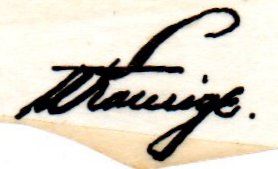 |
|
Gustavo Rochelt was manager in 1905. He moved in mid 1906 to become manager of the Banco de Jalisco. Rochelt signed $50 notes dated 14 October 1903 and $100 notes dated 1 October 1902 but not released until 1905 and 1906. He signed a few $20 notes dated 15 May 1905. |
 |
|
Reinhard Dickmann became managing director in August 1906The Mexican Herald, Vol. XXII, No. 174, 22 August 1906 and signed notes dated from 1906 to 1907. He resigned in July 1907. He then became Director Gerente of the branch of the Banco Nacional de México in Mazatlán, which he left in April 1910 to go to GermanyLa Gaceta de Guadalajara, 17 April 1910. |
 |
|
Pedro Porto was a businessman from San Luis Potosí, who occasionally served as a regidor on that city’s council. He took over as Director Gerente on 3 July 1907, following Dickmann’s resignationEl Contemporaneo, Tomo XIII, Núm. 2612, 5 July 1907; El Economista Mexicano, 9 May 1908. He resigned in December 1909 and was succeeded by Emilio StahlknechtThe Mexican Herald, Vol. XXIX, No. 96, 5 December 1909. On 8 January 1916 Porto was appointed manager of the Compañía Nacional Petrolera ‘El Oro Negro,’ S. A., which intended to drill for oil in lands next to the wells in Túxpam, VeracruzEl Pueblo, 23 January 1916. Porto signed notes $50, $100, $500 and $1,000 dated 1 May 1907 but these were actually not released until 1912 and 1913. |
 |
|
He was involved in mining but seemed to have suffered in 1909 and so accepted a more stable berth. He replaced Pedro Porto when the latter resigned in December 1909The Mexican Herald, Vol. XXIX, No. 96, 5 December 1909. He signed notes in 1910. |
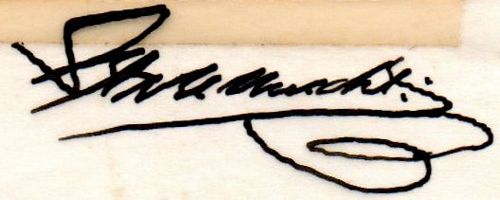 |
|
Manuel M. Villalobos Villalobos signed $20 and $50 notes dated 1 May 1907 but not released until 1914, and $1,000 dated 16 April 1914. |
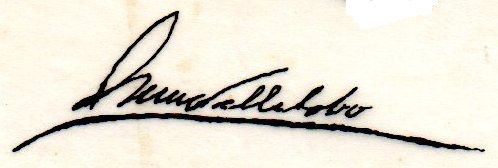 |
Consejero
Three of these consejeros (Guillermo R. Peterson, Eduardo and Gerardo Meade) also signed notes for the Banco de San Luis Potosí.
|
The Meade family had come to Mexico from Ireland in the first half of the 19th century and developed interests in agriculture and mining. In 1830 Dionisio Meade Roche had acquired the San Javier mine and hacienda de beneficio, three kilometres north of Guanajuato. He wrote to the brother Ricardo, who was in Ireland, who embarked from Liverpool on 12 April 1833, to travel to Mexico and invest in the mine. On 16 January 1841 Ricardo married Francia Emily Lewis, daughter of his partner, and had Matilde, Federico, Ricardo, Kate Helen. Gerardo and Eduardo. He died on 2 October 1865. In 1865 Federico, Gerardo and Eduardo Meade Lewis established themselves as “comisionistas, importadores exportadores” in San Luis Potosí. The firm Hermanos Meade, registered as “Casa de Federico J. y Eduardo Meade. Comerciantes, banqueros y comisionistas” was established in San Luis Potosí in 1867. In time they acquired shareholdings in haciendas, mines (such as la Minera Santa Maria y Anexas in Matehuala, La Preferencia mine and the Compañía Minera Santa Fe y Anexas. Gerardo Meade was a diputado suplente in the State Legislature from September 1901 to September 1903, was president of the Sociedad Potosina “La Lonja” in 1907, 1910 and 1914, and regidor propietario of the San Luis Potosí Ayuntamiento. He signed notes dated 1902 and 1903. |
 |
|
Gulliermo R. Peterson He signed notes dated 1902 and 1903. |
 |
|
He signed notes dated 1902 and 1903. |
 |
|
When he died, an obituary read: “Far removed, by the nature of his character, from politics, he had, however, sometimes to accept public offices, as Jefe Político and Deputy to the Local Legislature, in which positions he gave relevant proof of his aptitudes. The sphere in which he exercised his extraordinary gifts of energy and talent was the field of business, and, an indefatigable worker, he managed to make a fortune acquired mainly in agriculture. How many people had the satisfaction of treating Mr. Armería even once, knew how to appreciate the rare, the invaluable gifts that praised him; and the absence of such a noble and uplifting spirit has covered in mourning not only his most precious family, but the entire society of Aguascalientes. Let these lines therefore be a tribute to the memory of the loving father, the model husband, the upright gentleman and the faithful friend”Semanario Literario Ilustrado, 28 December 1903. He signed notes dated 1902 and 1903. |
 |
|
He was born in Querétaro on 16 September 1868. In 1892 he began his studies at the Escuela Nacional de Medicina in Mexico City and graduated in 1893. As an officer candidate he completed the Escuela Práctica Médico-Militar at the military teaching hospital and made his specialty training in ophthalmology in the United States and in Canada from 1893 to 1895. In 1896 he married María Elvira Camarena Aldana, another sister of Roberto Camarena, and worked in Aguascalientes. He was also a liberal thinking politician, active as a regidor in the city of Aguascalientes between 1903 and 1911, elected deputy to the state congress for Rincón de Romos in June 1903, and serving as Deputy Governor from 1910 to 1911An alternative view of Osornio as a well-rewarded corrupt lackey of the political elite is given in Gerardo Martínez Delgado, Cambio y Proyecto Urbano. Aguascalientes, 1880-1914. From 1914 he served as a military surgeon on the side of revolutionary forces during the revolution.
On 3 June 1915, during the Bajío campaigns between Obregón and Villa, Obregón was doing a reconnaissance of the terrain in the Hacienda de Santa Ana del Conde, very close to the city of León, when he was hit by a grenade shrapnel that cut off his right arm at the level of the lower third. Obregón, convinced that he was mortally wounded, took his pistol with his left hand and tried to take his own life, but fortunately he was saved because his pistol had no bullet in the chamber and his aides snatched the gun away. Obregón was bandaged and carried in a cot more than ten kilometres under enemy fire to the railway station of Trinidad. On the way he was given a narcotic by (then) Lieutenant Colonel Medical Surgeon Osornio. Obregón was transferred to the operating wagon where he underwent surgery, with Osornio assisting. Osornio was promoted to the rank of Brigadier General (Médico Cirujano) in 1916. From 1 June 1916 to 11 December 1917 as well as from 4 December 1920 to 16 December 1934 he served as head of the medical branch in the Secretaría de Guerra y Marina. He was one of the founders of the Escuela Constitucionalista Médico Militar where he was director and taught as Professor of pathology, medical therapy and ophthalmology. From 1933 to 1934 he was director of the journal Gaceta Médico Militar, the organ of the Mexican military branch. He died in Mexico City on 1 April 1945. He signed notes dated 1902 and 1903. |
 |
|
Luis Barrón owned the enormous Hacienda Pabellón in Rincón de Romos. He also was elected as a deputy for that district in June 1903, and was secretary of the Compañía Eléctrica de Aguascalientes in 1905. He signed notes dated 1902 and 1903. |
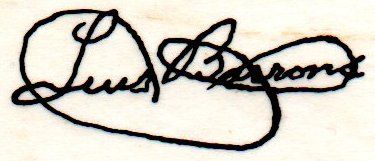 |
|
Roberto Camarena Aldana was born in 1859 to a well-established local family that owned the hacienda Cañada Honda. As a twelve year old he was kidnapped and his parents had to pay a ransom of $2,000La Voz de México, 11 January 1871; La Voz de México, 29 January 1871. His kidnapper was caught and executedLa Iberia, 16 March 1871; La Voz de México, 17 March 1871. In July 1885 Camarena married Florencia Chávez Arteaga. He died in Aguascalientes on 1 September 1916(?). Camarena signed $50 and $100 notes dated 1902 and 1903. |
 |
|
Eduardo Ramírez Adame was born in Zacatecas on 3 June 1857 but had moved to San Luis Potosí by 1886. He married Luisa Díez Gutiérrez Barajas, the cousin of the governor of San Luis Potosí. His wife’s families had owned extensive properties in San Luis Potosí and Tamaulipas since the eighteenth century and his marriage made him the administrator and legal representative of haciendas and ranches inherited by his wife as well as in charge of their production. He served as a lawyer and Director of the Instituto Científico y LiterarioEl Hijo de Ahuizote, 18 June 1899; as a magistrate of the Supreme Court of Justice of the state of San Luis Potosí in 1893ASLP, Secretaría General de Gobierno, Colección Leyes y Decretos, 10 April 1893; and as a deputy in the San Luis Potosí state legislatures uninterruptedly from August 1899El Contemporaneo, San Luis Potosí, Tomo IV, Núm. 904, 15 August 1899. Ramírez Adame was elected for the 1st district of San Luis Potosí, with Matías Hernández Soberón for the 2nd district to 1907. He was still a deputy when he died on 23 May 1906 in San Luis Potosí, aged 48 years oldEl Popular, 27 May 1906 . He was comisario propietario of the Banco de San Luis Potosí from 1900 to 1906 and signed notes of the Banco de Aguascalientes dated 1902 and 1903. |
|
|
José Guadalupe Ortega y Romo de Vivár was another (like Osornio supra) who had the good fortune to possess a medical degree and form an advantageous marriage. As a doctor he was in charge of the hospital of the Fundición Central. And he married Adela Douglas, the daughter of Juan (John) Douglas (1849-1918), who had emigrated from Scotland and become one of the richest industrialists in Aguascalientes, founder of the La Perla flour factory and a favourite of the governor Vásquez del Mercado. As such Ortega was twice a local deputy, involved in several speculative businesses and acquired, or inherited, many lots in the colonia Buenavista, which his father-in-law promoted. The Ortegas had a son, Edmundo Ortega Douglas, who, in honour of his maternal grandfather and out of love for his wife, built a Scottish medieval castle, the Castillo Douglas, in the centre of Aguascalientes, with a moat, a drawbridge, battlements, turrets, and a stained glass window, made in Vienna. Ortega signed notes dated from 1903 to 1910. |
 |
|
Eikel's company, Gualterio Eikel, S. en C., ran a hardware store, the Ferreteria “La Estrella”, in Aguascalientes, with “everything you needed for the ranch and hacienda”Boletín de la Cámara Agrícola Nacional de Aguascalientes, 1 July 1911 and large enough to be the victim of a bad cheques scamThe Mexican Herald, Vol. XXV, No. 55, 25 October 1907. He served on the boards of the Comité de Caridad (1905) and the local Cámara de Comercio (1909)The Mexican Herald, Vol. XXVII, No. 141, 20 January 1909. |
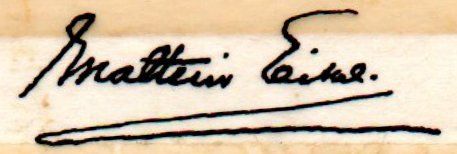 |
|
Bernal also served as a regidor on the Aguascalientes town council (ayuntamiento) and as a board member of the Aguascalientes Cámara de Comercio. He signed notes from 1903 to 1910. |
 |
|
Eduardo Meade owned 14% of the bank, as well as being a shareholder in the Banco de San Luis Potosí and the Banco de Guanajuato. The Meade family had come to Mexico from Ireland in the first half of the 19th century and developed interests in agriculture and mining. In 1830 Dionisio Meade Roche had acquired the San Javier mine and hacienda de beneficio, three kilometres north of Guanajuato. He wrote to the brother Ricardo, who was in Ireland, who embarked from Liverpool on 12 April 1833, to travel to Mexico and invest in the mine. On 16 January 1841 Ricardo married Francia Emily Lewis, daughter of his partner, and had Matilde, Federico, Ricardo, Kate Helen. Gerardo and Eduardo. He died on 2 October 1865. In 1865 Federico, Gerardo and Eduardo Meade Lewis established themselves as “comisionistas, importadores exportadores” in San Luis Potosí. The firm Hermanos Meade, registered as “Casa de Federico J. y Eduardo Meade. Comerciantes, banqueros y comisionistas” was established in San Luis Potosí in 1867. In time they acquired shareholdings in haciendas, mines (such as la Minera Santa Maria y Anexas in Matehuala, La Preferencia mine and the Compañía Minera Santa Fe y Anexas. In January 1874 Eduardo inherited Pitman y Co, a banking and commission company created by his uncle in 1843. He was a shareholder and president of the Compañía Minera La Candelaria y Anexas (Pinos, 1891). Eduardo Meade signed $5 and $10 notes, series B, dated 19 November 1906 and 1 May 1907. |
 |
|
Leautaud was on the board of the local Cámara de Comercio in 1909The Mexican Herald, Vol. XXVII, No. 141, 20 January 1909. He signed notes dated 1910. |
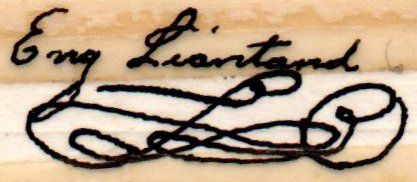 |
|
Felipe Torres was Presidente Municipal of Aguscalientes in 1921. He signed notes dated 1910. |
 |
|
Carlos Sagredo (see supra) Sagredo signed $20, $50 and $100 notes dated 1 May 1907 but issued in May 1913 and $1,000 notes dated 16 April 1914. |
 |


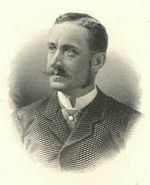 Pablo Emilio Stahlknecht was originally from Durango, where his family ran the
Pablo Emilio Stahlknecht was originally from Durango, where his family ran the 